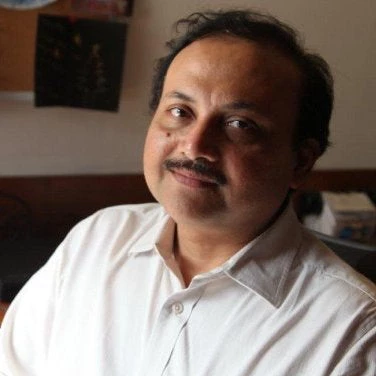
The chugging of rail engines often makes me nostalgic, as most of my childhood was spent in a small town near a railway junction in eastern India. During my recent trip to Korea, I was, therefore, looking particularly forward to the trip to Korea Rail Research Institute (KRRI). What unfolded during this visit, not only satisfied my nostalgia but has stimulated interesting deliberations around replicability of a very novel railway research model here in India. This visit to KRRI, as well as several others during my trip to Korea were organized by the Korea Green Growth Trust Fund (KGGTF.)
KRRI was established in 1996 to accelerate development of the railway sector in Korea facilitated by the construction of the Seoul-Busan high-speed rail line. The institute’s stated objective is to contribute to the development of state and business industries through continuous R&D in the fields of railroads, public transportation, logistics, and the spreading of its work in Korea. Over the last twenty years, KRRI has focused on the developing cutting edge railroad technology with 400 specialized researchers and with 300 forms of high technology research equipment, each of which was developed by KRRI. In its sprawling campus of 9 Acres, besides the main office building, KRRI houses 12 highly advanced and automatized testing centers and tracks including dedicated facilities for high-speed rail and metropolitan railroad systems. The testing facilities include twenty real scale test machines include integrated test system for infrastructure, multi-axial test systems for track components, high-speed wheel-rail contact simulator, propulsion equipment performance tester, bogie dynamic simulator and more cutting edge technology equipment which are rare finds even in highly developed countries with much larger and more mature rail networks. Experiencing some of the live tests, particularly seismic failure of a real scale column on the DOF seismic table was particularly impressive. While these technology achievements of KRRI were impressive in themselves, what left me most impressed was perhaps the institute’s underlying budgeting/business model.
KRRI is a public sector institution and the Korean National Government funds a core set of activities. However, KRRI and other such national institutes are evaluated in part on their ability to commercialize the results of their work. They are encouraged to find private sector partners – chosen in a competitive transparent manner. In the beginning of each calendar year, KRRI publishes a list of research areas they would like to pursue and invite interested private sector agencies to partner for those research projects. An independent evaluation committee screens the private sector expressions of interest and selects appropriate partners for each research projects. The research institutions then use their own and private sector funding to conduct the core research. The institutions use their own staff time and equipment etc. while the private sector funding is sued for laying test tracks, performance monitoring etc. If the core idea does get commercialized, the private sector partner benefits in being able to take the idea to market first; but the research institutes keep the patents from the core research which are ultimately available for all Korean companies to license. The research institutes get a predetermined share (about 3-5%) of the commercial revenue (profits) made from commercial application. An example of a successful commercial venture developed through such partnerships is the Korean high-speed train (KTX-sancheon) which was developed by KRRI and ROTEM, the major Korean rolling stock manufacturing company. Following the same framework, KRRI and ROTEM are developing a next generation high-speed train, HEMU-430, with the operational speed of over 400km/h.
We saw how this system of incentives helped ensure that the myriad of research ideas being explored ranging from relatively incremental solutions (x) to much more blue sky innovations (such as a railroad with dynamic tracks that allowed rail to road container transfer without the need for any cranes or other equipment) benefited from a constant discipline of looking towards commercialization! This structure also allows significant leverage of the funds institutes like KRRI receive from the government. In 2015, Government grants accounted for only about 38% of its annual budget of about USD 110 million.
As I returned home I remain struck by the relevance of this research model to India both in terms of the substance - research on rail related systems and technologies – as well as an underlying incentive structure to ensure that the research remains operationally relevant. India has a rail network of about 67,000 km relative to 4,000 km in Korea. Yet, the institute/department responsible for research and development (RDSO) in Indian Railways carries out limited applied research and is engaged in certification of infrastructure and rolling stock components. Indian Railways Vision - 2020 aims to transform IR from a net technology importer to technology exporter. To realize this vision, a good business model for research with right incentives for stakeholders is an imperative.
Resource constraints and ensuring that the research stays locally and operationally relevant are significant challenges that are often used as reasons not to support a substantive program. But KRRI’s success in leveraging government finances with private sector partnerships could be a model for India to emulate. Supporting manufacturing is a strong focus of India’s current Government – and supporting the modernization of Indian Railways in partnership with Indian manufacturers could only help the government’s ‘Make In India’ campaign. Can RDSO aspire to set up a research institute with automatized testing facilities and undertake research activities in partnership with the private sector?
I have been discussing with colleagues over here and encouraging a closer institutional bond of RDSO and other Indian railways institutions with KRRI, particularly in active exploration of possible replicability of this innovative applied rail research model. Trust, we would be able to facilitate the beginning of that mutually beneficial twinning arrangement soon.


Join the Conversation